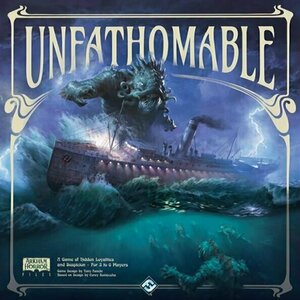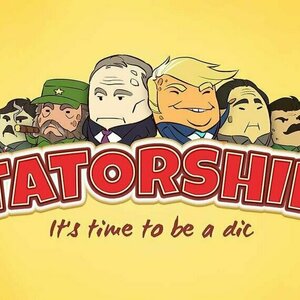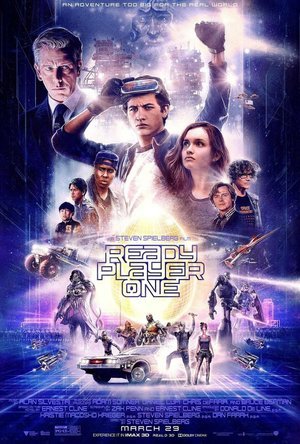
Beat the Boss 2 (17+)
Games and Entertainment
App
The Boss is back and ready to make your life a living hell. But you're not the same good guy taking...

Beat the Boss 2
Games and Entertainment
App
The Boss is back and ready to make your life a living hell. But you're not the same good guy taking...

Finn in 1989 - Choice of a Lifeline - Episode One
Games
App
Finn in 1989 is a text-based adventure, soaked in 80's nostalgia. A young boy discovers he's lost in...

Pandemic Legacy: Season 1
Tabletop Game
Actions have consequences from one game to the next as you strive to avert global disaster in this...

On the Rocks
Tabletop Game
Welcome to "On The Rocks" cocktail lounge, where the city's best mixologists expertly prepare...

Unfathomable
Tabletop Game
The year is 1913. The steamship SS Atlantica is two days out from port on its voyage across the...
Purple Phoenix Games (2266 KP) rated Tatorship in Tabletop Games
Feb 18, 2020
Disclaimer: We were provided a copy of this game for the purposes of this preview. This is not the finished product, so some of the components may change in the final printing. -L
Tatorship is a card game of hand management and bidding in which players are racing to complete their secret political missions before their opponents. To set up the game, place the 6 Rights in their respective piles in ascending order. Each player randomly selects a Tator, Top Secret Mission, Bottom Secret Mission, and Executive Mission, as well as Action cards and a Bluff card. The Tator is your character, and provides a unique Executive power. The Mission cards (Top, Bottom, and Executive) each refer to specific Rights in the play area. Action cards provide resources necessary for interacting with the Rights, and for use during the Election.
On your turn, you interact with the current Rights on the table. The Rights in play act as the ‘rules’ for the current round. For example, one Right tells you how many Action cards to draw each turn, and another tells you what your hand limit is at the end of your turn. During this phase, you will also have the opportunity to ‘erode’ (remove) Rights from play. To erode a Right, you must pay the resources displayed on the Right card. Each Right has 4 cards, and the bottom-most card must be showing for that Right to be considered to be completely eroded. Your secret Missions require you to erode specific Rights in play, so you must strategize how to use your resources to best benefit your Missions. After all players have taken a turn, the game moves to the Election phase. During the Election, players are casting votes (the # of resources on the Action card is the # of votes it is worth) in an effort to elect a player to be the Executive for the next round. The Executive goes first in the next round, and gets to assign Roles to all players. In order to complete your Executive mission, you must have the Executive card at time of completion. You can vote for an opponent, as well as yourself. Cast a vote with your Bluff card, however, and your votes do not count! Trick your opponents into thinking you’ve voted for them, but reveal the Bluff and get those votes back. Didn’t win the Election? That’s ok! Take a Backstab card as a condolence. Backstab cards can be played at any time and can negatively affect your opponents, or could give you a leg up over opponents. Play continues until one player has completed all 3 of their secret Missions.
If you are confused at all by the rules/gameplay overview above, I have to admit that I am too. The rules provided with this game are extremely vague and confusing to understand. Not even a rulebook, these rules are compiled on 3 separate playing cards. The text is sparse, ambiguous, and contradictory. For example, one card says that each Right is followed once per turn per player, but in any order. But one of the Rights pertains to the Election phase, which I believe only happens once per round? Or does it happen on every single players’ turn since each Right is supposed to be followed by every player on every turn? The ambiguity of the rules bleeds over into other cards as well. Some cards say to ‘discount’ a Right, but nowhere does it say what ‘discount’ means. Do you immediately erode that Right by one? Or do you just pay one fewer resource to erode? There is no clarification anywhere, and that made this game frustrating to play.
Another qualm with this game is that it is supposed to be educational, but I do not think it achieves its goal. I do have to commend the creators for their efforts, but I think they fall flat. Every Action card has small text at the bottom that details the political concept addressed on the card. Here’s the catch – the text is educational, but it is so small that it can be easily ignored. It also has no bearing whatsoever on the gameplay, so I have to admit that I almost never read any of that extra text.
In theory, this game could be fun and educational. In actuality, though, it falls flat. The ambiguity of the rules meant that we played differently nearly every time. We tried interpreting the rules in several ways, but ultimately we just got frustrated by not knowing how everything actually works. With some serious rules work, this game has the potential to be something good. But in its current state, it feels more like a half-baked potato.
Purple Phoenix Games (2266 KP) rated Buru in Tabletop Games
Feb 22, 2021
Buru (http://burugame.com/)is a mid-weight economic worker placement game with a large dose of bidding thrown in for fun. In it players are visitors to the island sent to compete to become the governor of Buru by hiring indigenous peoples to assist with tasks, by providing fish for the peoples, pleasing the island’s elders, and by paying homages to the spirits of the land. The emissary who can utilize all their resources efficiently and impactfully will be deemed governor of Buru and winner of the game.
DISCLAIMER: We were provided a prototype copy of this game for the purposes of this review. These are preview copy components, and I do not know for sure if the final components will be any different from these shown. Also, it is not my intention to detail every rule in the game, as there are just too many. You are invited to download the rulebook, back the game through the Kickstarter campaign, or through any retailers stocking it after fulfillment. -T
To setup, follow the instructions in the rulebook. There are just too many steps to detail here and the rulebook is fantastic. Once setup, the play area should look similar to the photo below.
The game of Buru lasts five rounds, and each round consists of five phases of the day: Dawn, Morning, Noon, Afternoon, and Dusk. At the end of the fifth round the game is over and players will tally points to arrive at the winner.
During the Dawn phase players will flip over the top two Decrees tokens from the middle of the main circular board. These Decrees will be placed in certain areas and are worth bonus points or other advantages for the round. Also during this phase the Forest cards will be reset from the previous round. Once complete play moves to the Morning phase.
In the Morning players will be sending out their numbered Explorer tokens (from 1-5) onto the various board areas in turn starting with the current Emissary (first player). Each player will place one of their Explorer tokens at a time until each player has only one Explorer token left. Players may place multiple Explorers in a location to increase their bid for majority, but these Explorer tokens are placed face-up (literally with the face showing and the number on the board not showing) so that their values are hidden. Once Explorers are placed, play moves to the Noon phase.
At Noon the people must fish for food and have lunch. The leftover Explorer token that was not used in the Morning is then revealed and its value is converted to fish. Fish are needed to recruit islanders and are converted into other resources. Fish are tracked on the individual player boards. After a hearty lunch play continues into the Afternoon.
The Afternoon is where much of the action in Buru takes place. During this phase the Explorer tokens that were placed in the Morning are revealed and players take actions in each area by order of majority in each area. First the highest-bidding player will claim their chosen action space, then the next highest bidder, and so on. The Forest is resolved first. Players reveal the Explorer tokens in the Forest and whichever player has majority in this area is able to place their tokens a claim space on the board and will receive a Forest card of their choice. Forest cards are typically resources immediately earned by the player. Resources include Clay, Palm Leaves, and Ebony. The player with majority also earns the favor of Gunung (green spirit) and takes its giant statueeple.
Next, the Shore is resolved in the same manner. The Shore is where players may use their supplies of fish to recruit islanders to their taskforces and carry out tasks. The majority leader in this area chooses a space to place their Explorer tokens and resolves the action. This could include purchasing islander cards and refreshing the offer of islander cards in whichever order the player chooses. The player with the majority also earns the favor of Banyu (blue spirit) and takes its giant statueeple.
The Village is the area where islanders are able to complete tasks. The majority leader in this area chooses a space and takes the actions. These actions include activating islanders for the actions printed on the bottom of their cards and possibly even earning more fish. The player with the majority also earns the favor of Manuk (orange spirit) and takes its giant statueeple.
Finally, The Sacred Lake is resolved in the same manner. Here players are able to pay tributes to the spirits in order to earn bonuses from them. The majority leader in this area chooses a space to place their Explorer tokens, earns an immediate Esteem (VP tracked along the outer edge of the board), and takes the action of the space claimed. These spaces offer opportunities to pay tribute to one or more of the spirits as well as earning an Elder card, which provides conditions for earning bonus points at the end of the game. When a spirit is tributed they offer bonus Esteem cards and other benefits to be used. Once this area is completely resolved and players have all taken their turns play moves onto Dusk.
In Dusk players will reset the board for the next round of play. Players retrieve all their Explorer tokens from the board and untask their islanders that have completed tasks this day. After the fifth round the game is over and players tally their scores from their position on the Esteem track, any spirit Tribute cards earned, and Elder card point conditions met. The player with the most points will be crowned the winner!
Components. Okay, I have to give a giant shout-out to the team at Crafty Games. This is one of the highest-quality prototypes I have ever played in terms of component quality. When I opened the game box all components were separated into baggies and card cases and LABELED with the number of components, the titles, and even a picture of the components to be placed within. I don’t even organize my games to this level and I feel I am a tad OCD about my game organization. Kudos here. But also the components are all fine quality and the finished product promises to be just spectacular if this is what is received as a prototype.
I love the art and art style throughout this game. It is difficult to have theme shine through in a very Euro-style game, but I did feel the theme here. The art is very suggestive of island life, and Crafty Games even hired Cultural Consultants to assure all avenues are culturally appropriate. What a great call. I wish all publishers would be so thorough.
The gameplay is also quite stunning. The game just flows so naturally and everything makes complete sense. Of course you need to collect natural resources before recruiting islanders before asking said islanders to complete tasks before you pay respects to their spirits. I like the flow, and after a couple rounds I no longer needed the rulebook as a crutch.
I have very much enjoyed my plays of Buru for many reasons. The game is absolutely gorgeous. The art sings and truly adds to the gameplay. The rules are not light, but not over my head, and I appreciate that. The choices given to each player are crunchy without being too burdensome, and players of many skill levels will be able to find joy contemplating when and where to send their Explorers in each area. The game builds up to a big ending where many points are scored from places unknown to opponents and bulleting ahead from last place to first from exploiting bonus cards is so satisfying.
It is easy to understand why I love this game and would certainly recommend it to all gamers. If you have been looking for something a little heavier in your collection but don’t want to go TOO heavy, please do yourself a favor and consider backing Buru. Crafty Games has been working on some truly great games here the past couple years and I am excited to see where Buru ends up after another undoubtedly successful Kickstarter campaign. I will always be up for a game of Buru, and I hope to play it often as the years continue.
Movie Metropolis (309 KP) rated Ready Player One (2018) in Movies
Jun 10, 2019 (Updated Jun 10, 2019)
Ready Player One follows Wade Watts in the year 2045, where the world is in decline and people fill their time in the OASIS, a virtual world where everything is possible and the only limits are people’s imagination. When the creator of the OASIS dies, he releases his will to challenge all the users of the OASIS to find his very own Easter Egg inside the game, whoever wins becomes the new owner.
The OASIS is filled with gaming and pop culture references that will always leave you with a smile of nostalgia. When we are transported to the OASIS, the computer animation and voice acting is pretty much spot on. A lot of the humour comes from Spielberg’s direction especially from when we see people in the real world reacting to the events within the OASIS. Without giving too much away there is a scene about halfway through that pays homage to one of the best horror movies of all time: this is the true highlight of the film that I’m sure everyone will enjoy.
In the real world, everyone gives a performance that they can be proud of, particularly Mark Rylance who plays James Halliday. Rylance’s performance is filled with wisdom and creativity but it’s clear to see the moments of vulnerability and clumsiness that could only be put across from a performer like Rylance. Tye Sheridan and Olivia Cooke give adequate performances that they can be proud of and prove that they can lead a film quite comfortably in the future. Simon Pegg also makes an appearance and although much more subtle then what you would expect from the actor, it pays off in an amazing way towards the end of the movie.
Where the film falls a bit short is in the real world. The OASIS is such a joy to explore because it has such elaborate details hidden within. When the film transitions back to the real world, however, it falls a bit flat because it’s not as fully explored. Being a dystopian world you would hope Spielberg would explore that a little more and answer questions about how it came to be.
The action sequences are very good in both the real world and the OASIS and have that classic Steven Spielberg touch you would expect. Although the script relishes in funny one-liners, these can sometimes become a little too cheesy in their delivery.
Steven Spielberg took on an impossible task and does justice to the novel and everyone should really appreciate the genius of the man. He’s created a world that everyone would dream to be part of, and I urge every person who is a fan of his work, or a major lover of pop culture to go and watch this epic tale. I would also like to plug the book, as it does differ from the film enough for you to give it a try, and you will not be disappointed if you enjoyed
https://moviemetropolis.net/2018/03/22/ready-player-one-review-virtually-amazing/

Skoove - Learn Piano
Education and Music
App
Learn piano with Skoove. Have you always wanted to play piano, but didn’t know where to start?...


